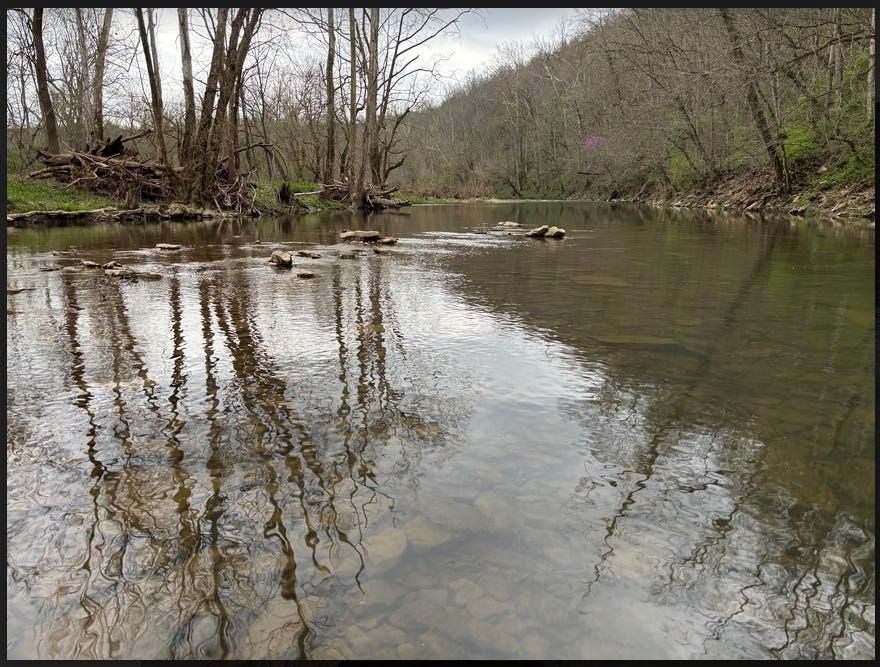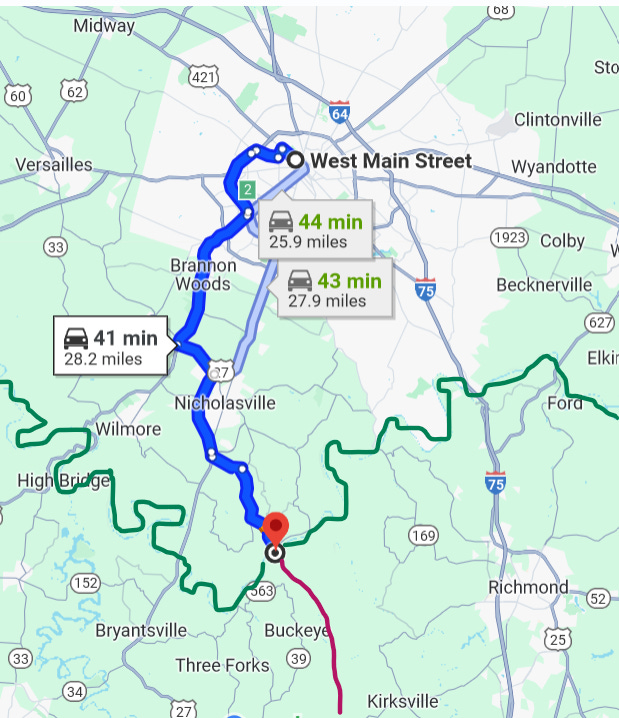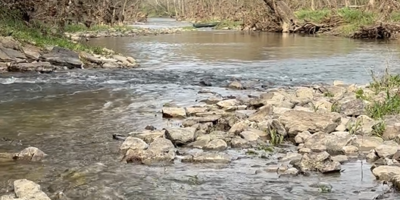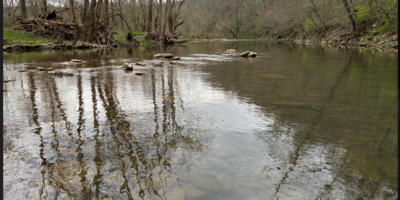Part 3 of a Paint Lick up-back
How many parts does it take to adequately capture a 2 mile paddle? Three!
Part 1: The unlikely wilderness of your home
Part 2: Put-in to Grounding Zone 1
I reach my Paint Lick grounding zone in a lazy 30 minutes, beaching on creek-left beneath a tiny Madison County bottomland abandoned sometime during the Clinton administration. To my right, a high Garrard County limestone ridge races toward the creek, pinching off the considerable bottom that I have been following since leaving the Kentucky.
I have not been to this place in over 10 years.
In 2009 and again in 2011, I had camped here with friends while completing overnight trips of pools 7 and 8 of the Kentucky River. The two trips nearly book-ended a four-year odyssey to paddle and write about the entire mainstream of the Kentucky River. I could not know it then, but the trips capture a certain highwater mark in my own life. Gainfully employed at last at 35 in the profession I had trained half my life for, new homeowner, new father, confidant long-paddler of the Fayette wildlands, owner of a successful start-up local media outlet. After moving roughly every four years of my early life, a native of nowhere, I had at last come into my own country, a place I could know intimately in my bones and heart and head and across the length and breadth of my remaining human time. I could have floated all the way to New Orleans on those tides.
Wes, my companion on the 2011 trip and ever the observant poet, briefly alighted on this high tide of mine while otherwise surveying our arrival to this place on Paint Lick.
Five tom turkeys sail from the high, wooded ground of Madison County across the creek and disappear in strikingly green winter wheat along the bottomland on the Garrard County bank. Danny whistles a jaunty tune. Though the nominals change through the flood of time, the auxiliary of river syntax is ever predicated on exuberance: to exuberate, to overflow. Even in times of drought and stagnation, rivers overflow experience. To be on or near the river is to be exuberant—thoughts, visions, dreams humbled and filled by sheer awe of geologic time. Morphologically, rivers follow a path of minimum variance, but their influence on form of thought is always radical. They live the history of the earth, and on them we feel life that outlives our lives.

Today I scramble up the bank, expend some moments walking upon the old campsites, and exuberate.
Grounding Zone 2
The spring-time water conditions of my present float allow me to continue up-creek past my former campsites, into what is for me terra nullius. I drag the boat upriver a few feet through swift riffles and hop back in, paddling into the pool above it. In this way—20 feet of drag followed by 200 feet of pool—I make another half-mile up the creek and decide to ground out at the bottom of a small island.
Here, the general terrain has jumped banks but changed little. On the Madison County side, the pinched elder-filled bottom has given way to a pastured field that backs to what appears to me from the water as a far-off line of rail tracks. On the Garrard County side, the high ridge that I have followed since leaving the old campsite continues to run as far as the eye can see.
I hop out of the boat and wade the creek partway up the Madison County side of the island until a thin strip of land allows me easy passage across it to the Garrard County side, where the current runs deeper by a foot. I crack my beer, re-enter the creek, shimmy in up to my shins, and stand. For about an hour. My white winter legs anchored, my hips and neck on slow swivel, I must appear to any being happening to observe me like a stationary Mars rover, or an as yet undiscovered bird species, the fatted land-heron.

Downstream Riffles & Return Encounters
Like most up-back trips, the return on Paint Lick is with a pleasing current of downstream riffles. Camera in one hand, I mainly concern myself with an awkward one-handed ruddering system and quietly take in the moving diorama of aquatic and bankside life at work in the bluegrass.
Reader, I have heretofore written of the wondrous earthen beauty and natural flow of Paint Lick Creek. Do not let my descriptions fool you. Like most inner bluegrass streams, the banks and water of Paint Lick are not wholly pristine. Fraying tarps, flushed hub-caps, algae’d cans and the residual foam of acres upon acres of cow-piss and other urban run-off like myself abound. We are distant but not disconnected.
But still, our modern intrusive bodies, weathered and given over to the place, generate here their own fecund beauty. I find myself leaving the current to tie up and video some of them.
In 30 minutes time, I re-pass the Garrard County bottom and come upon two young men on the banks setting fishing lines. I assume landholders, family of landholders, or friends of landholders. Expressing due deference, I withhold acknowledgment until my canoe floats to near parallel with them on the bank.
“Nice bottom you got there,” I say, interrupting their conversation and gesturing to the creek and the lands behind them. For a moment, the men stop what they are doing and survey the area, as if for the first time this year. Both smile. One says, “It is very nice” and then returns to the matter of the fishing lines.
I, too, return to my pursuits and in no time round the final bend on my way to the mouth of Paint Lick. The Kentucky River and my Jessamine County put-in come into clear sight. The teens idling away in the parking lot when I arrived have since skedaddled. Save for my truck, the place is, for the moment at least, emptied of humanity.
Thirty minutes later, gear and boat loaded, an old SUV of indistinguishable model enters the parking lot and rolls up to me. The passenger side window rolls down to show an old man driven by a middle aged woman. “How’s the fishing?” he asks, gesturing to where I had just floated. “Used to be great fishing here.”
“I don’t fish,” I say, for probably the thousandth time over the decades of my water travels, “but I hope to get to it one day. I’m too busy sightseeing.” The driver, silent, smiles. The old man, pleasantly undeterred by my response, repeats his fishing line, then adds, “I used to come down here all the time.” The driver again smiles, nods, stays silent.
It’s at this point that I begin to understand the scene. In the midst of great loss, the river is a grand palliative of memory and sensory feeling. Bit by bit, we go, but the river remains for us to grasp at in mimicry of sinking turtles. Nearing 50 and with over two decades of Kentucky River slackwater paddling under my belt, I know this man. For a few minutes in this Jessamine County parking lot, we exuberate a syntax of life here that will outlive our own. People. Fish. Bugs. Drownings. Crossings.
“I’m Roy Lamb,” he says by way of goodbye, holding out his hand for me to grasp. “I’m 80. It’ll kill you.” And with a slight thankful nod in my direction from his driver, the two disappear into the horizon of the Jessamine County landscape. A few moments later, so do I.






Leave a Reply